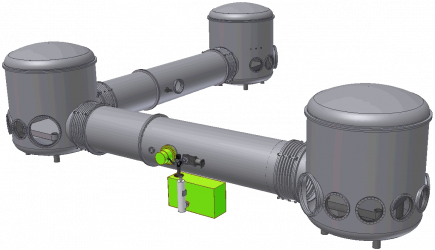What is the AEI 10 m Prototype?
The Albert Einstein Institute (AEI) 10 m Prototype Facility is a laboratory located in the AEI in Hannover, Germany. This is being constructed as a combined effort of the Max-Planck-Institute for Gravitational Physics (AEI), the Institute for Gravitational Physics of the Leibniz Universität Hannover, and the Quantum Frontiers cluster of excellence. We are also a member of the LIGO Scientific Collaboration and the GEO Collaboration. The primary instrument is intended to be an ultra-low noise interferometer with a layout closely resembling that of current gravitational wave detectors. It consists of an L-shaped Michelson interferometer with approximately 10 m long arms with Fabry-Perot cavities. This interferometer will be limited solely by quantum noise across a frequency range of 50-500 Hz. The optical construction will be housed within a large vacuum system, which can be rapidly pumped down to pressures of the order \(10^{-6}\) mbar within one week, enabling rapid turn-around times for experiments. The sensitivity target is sufficient for the interferometer to be able to reach the Standard Quantum Limit (SQL). The prototype facility utilises advanced infrastructure and a range of techniques to suppress classical and technical noise sources in order to be SQL limited. These include:
- an ultra-low noise laser system to inject light into the interferometer
- seismically pre-isolated optical tables
- optics suspended from multi-stage pendulums for additional seismic isolation
- a digital control and data system to read signals for data acquisition, processing and control of the entire experiment
What are the goals of the AEI 10 m Prototype?
As a prototyping facility, our primary objectives are to develop, test and evaluate techniques and technologies to improve the performance of both current and future generations of gravitational wave detectors, and to train the next generation of scientists who will continue to develop these methods and help to operate and improve existing and future detectors. Prototyping facilities like ours play a vital role in bridging the gap between proof-of-principle tabletop experiments and their implementation in full-scale gravitational wave detectors. Since the prototype is not built to measure gravitational waves, we can afford to take the interferometer offline in order to install and test new devices or tweak existing parameters without fear of missing potential astronomical signals.
One of our main focuses at the AEI 10m Prototype is to investigate potential methods of overcoming the SQL. Quantum noise is one of the dominant noise sources (along with coating thermal noise) limiting the sensitivity of current and future gravitational wave detectors. With an interferometer overwhelmingly limited by quantum radiation pressure noise and quantum shot noise, we will provide a facility to evaluate the performance of various quantum non-demolition (QND) techniques that can potentially help to improve sensitivity of future gravitational wave detectors.
